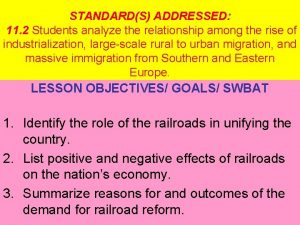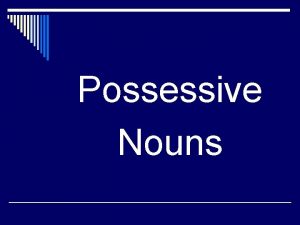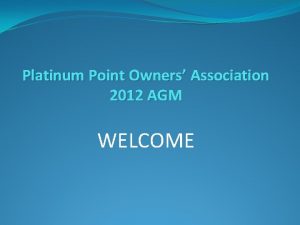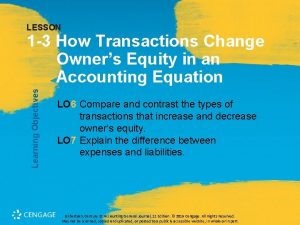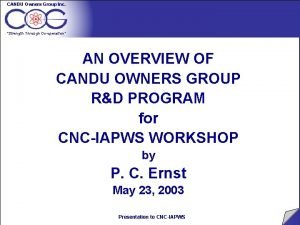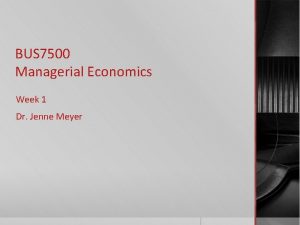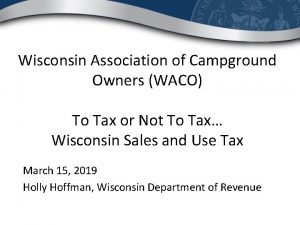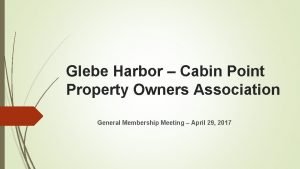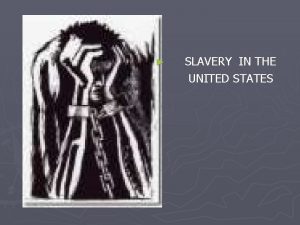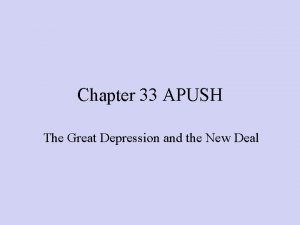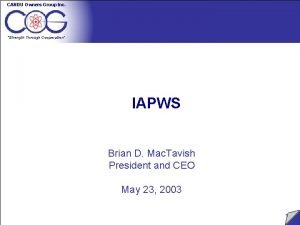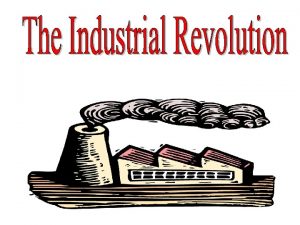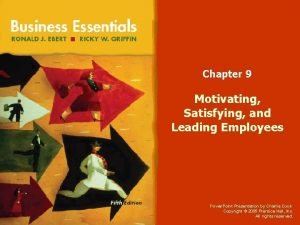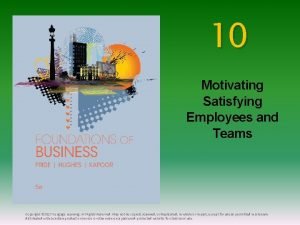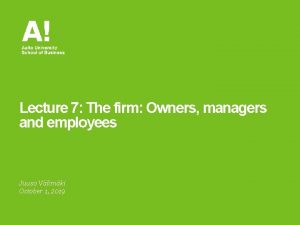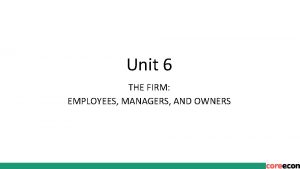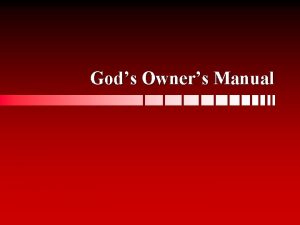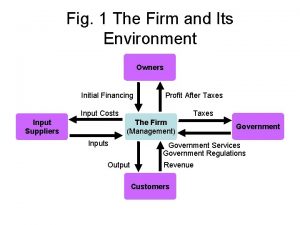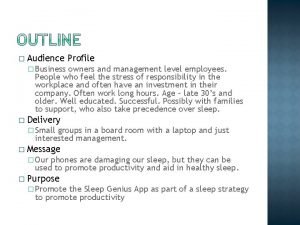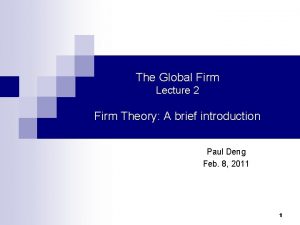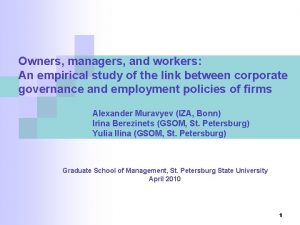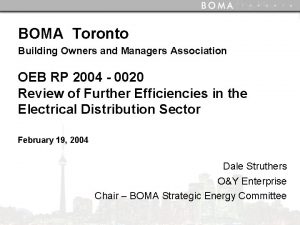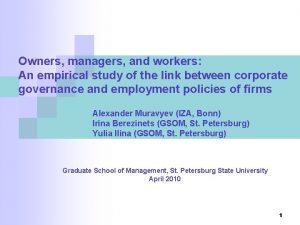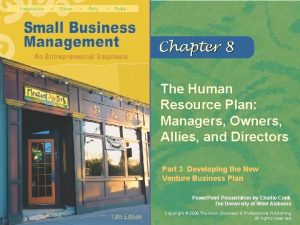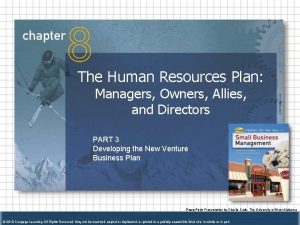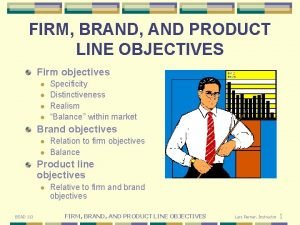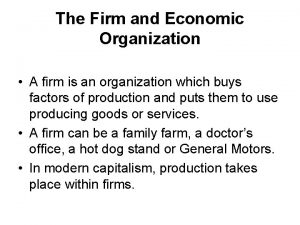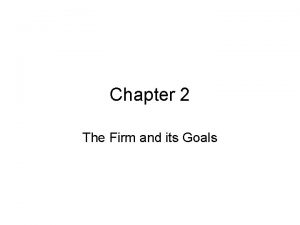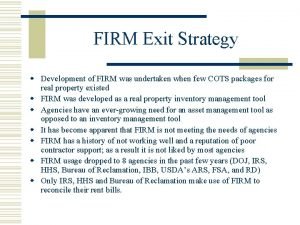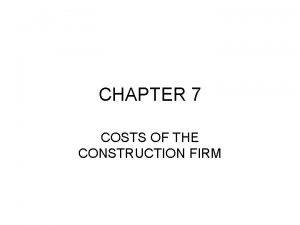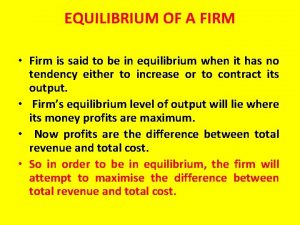Lecture 7 The firm Owners managers and employees


































- Slides: 34

Lecture 7: The firm: Owners, managers and employees Juuso Välimäki September 29, 2020

OUTLINE A. Introduction B. Firms C. Owners and Managers D. Employees E. Labour Discipline Model F. Principal-agent models

Introduction: Context for This Lecture Work is an important part of human life and economic activity (Lectures 2 -3 explored the individual tradeoff between work and leisure) In models of economic interactions, bargaining determines the division of social surplus. (Lecture 6) All parties gain from these interactions, but have conflicting interests over how these gains (profits) are shared. • How are wages determined within firms? • What are the economy-wide effects of firm interactions?

This Lecture • Analyze how firms differ from markets • Use a model of strategic interactions within the firm to explain how wages are determined, and how this influences unemployment • Explain the problem of incomplete contracts and hidden actions • Contrast with competitive labor market (Principles II will take a more detailed look at the labor market)

Firms: What is a firm? Firm = a business organization which maximizes the profit from its operations • Employs workers and rents or owns capital • Purchases intermediate goods from the market to produce goods and services to be sold in the market • Intermediate goods: goods used as inputs in the production of the final product to be sold in the market • Profit is the difference between market revenues from sales and costs of operation (labor and capital costs and purchase of intermediate products) • May have market power to set the price of its products

Firms vs. markets In a capitalist economy, the division of labour is coordinated in two ways: firms and markets. Coordination within firm differs from coordination via markets: • concentration of economic power in the hands of the owners/managers allows them to issue commands to workers • Power is decentralized in markets, so decisions are autonomous and voluntary • “The firm in a capitalist economy is a miniature, privately owned, centrally planned economy. ”

Structure of a firm • Owners decide on long-term strategy • Managers implement their decisions by assigning tasks to workers and monitoring them • Solid arrows denote commands, dashed arrows information flows

Contracts Firms and markets differ in the contracts that form the basis of exchange. Contract = a legal document or understanding that specifies a set of actions that parties to the contract must undertake. • Contracts for products sold in markets permanently: transfer ownership of the good from the seller to the buyer. • Contracts for labour temporarily transfer authority over a person’s activities from the employee to the manager or owner.

Relationships within a firm Unlike in markets, relationships within a firm may extend over a long period of time. • • creation of network of colleagues acquisition of skills necessary for the job These skills, networks, and friendships are firm-specific assets. They are valuable only while the worker remains employed in a particular firm. When the relationship ends, value is lost to both sides. It is important to take good care of this relationship

Owners and Managers: Separation of ownership and control Managers ≠ owners Separation of ownership and control = when managers decide on the use of other people’s funds. Why is this separation so prevalent? What other forms of organizing are there? What explains these alternative forms in particular markets? Economics of organizations

Asymmetric information • The dashed upward green arrows represent a problem of asymmetric information between levels in the firm’s hierarchy. • Owners or managers do not always know what their subordinates know or do, not all of their directions or commands are necessarily carried out. • Do the managers always want to report favourable market conditions? • Can the managers see directly the work effort of their employees?

Owners and managers: conflict of interest The firm’s profits legally belong to the people who own the firm’s assets. • managers’ actions have impact on profits • but if profits increase thanks to managers’ work, they will not automatically benefit This may create a conflict of interest between managers and owners.

Aligning interests To solve the conflict of interest between managers and owners: • link the managers’ pay to the performance of the company’s profit or share price • monitor the managers’ performance But this is not easy: • performance depends on factors beyond managers’ control Ø how large is the impact of any single individual on performance? Ø if effort is costly to individuals, social dilemmas in the firm may result • maybe the most important aspects of individual performance are the hardest to monitor

Employees in Firms: Incomplete Contracts Hiring employees is different from buying other goods and services. The contract between a firm and its employees is incomplete: • some tasks depend on future (unknown) events • some aspects of the job are difficult to measure and base wages on e. g. effort Incomplete contract does not specify, in an enforceable way, every aspect of the exchange that affects the interests of parties. The quality of employee services depends on the terms of the relationship: successful employment relation can be seen as repeated gift giving between employers and employees

Piece rate pay Why not base pay directly on output: pay a fixed rate for a completed construction project, fixed pay per liters of berries picked etc. Piece rate work = a type of employment in which the worker is paid a fixed amount for each piece of production. Piece rate pay gives workers an incentive to exert effort. Nevertheless, they are rarely used in most of today’s firms: • it is difficult to measure output in modern jobs • employees often work as a part of a team

Workers’ effort If firms can’t directly measure effort, why do workers work hard? Social concerns • work ethic: upbringing, self-signaling etc. • feelings of responsibility and solidarity towards other team members • to reciprocate a feeling of gratitude for good working conditions (gift giving to the employer) Selfish motives • benefits for measurable output • promotions (based on measured or reported outcomes) • fear of being fired (fear of losing a good deal)

Employment Rents Employees fear getting fired when they are paid more than their opportunity cost of working given by their reservation option: by working, they receive employment rent. Employment rent = cost of job loss, which includes • Lost income while searching for a job • Costs required to start a new job e. g. relocation • Loss of non-wage benefits e. g. medical insurance • Social costs (stigma of being unemployed)

Calculating Employment Rents Reservation wage = opportunity cost = value of the next best option (other employment or unemployment benefits) Employment rent = wage – reservation wage – disutility of effort

Losing a job in Finland How to estimate the monetary effect of job loss? • challenge for empirical work: selection • those losing their jobs might be different Ø maybe managers get rid of unproductive workers • future wages may be lower because Ø unemployment lowers lifetime expected income Ø less productive workers would have earned less in any case • more credible etstimates of the effects for plant closings during recessions

Earnings and income after job loss due to plant closing Source: Gathmann, Jernström, Huttunen, Stitzing, Sääksvuori: ”In Sickness and Health: Job Placement and Health Spillovers in Couples”, 2020, IZA DP 13329.

Labor Discipline Model: Wages and Effort The employer cannot directly measure the worker’s effort Large employment rent → large cost of job loss → worker puts in more effort to reduce chance of getting fired One way to increase the cost of job loss is for the firm to raise wages.

The Employment Game 1. The employer chooses a wage per hour worked. As long as the worker works hard enough, she will keep her job at the offered wage. 2. The worker chooses a level of work effort, taking into account the costs of losing her job if she does not provide enough effort. Payoffs: • Firm: profit = worker's output – wage • Worker: employment rent

Backward Induction This is a two-stage game (similar to ultimatum game) • In the last stage, after receiving a wage offer, employer chooses her effort level • When offering a wage, the employer can anticipate the resulting effort • The wage is chosen so that the benefit to the employer from the resulting effort net of wage costs is maximized • Backward induction means that the analysis starts with the last stage

Worker’s Best Response Curve Best response curve shows the optimal amount of effort workers will exert for each wage offered Represents the firm’s feasible frontier for wages and effort Slope of best response curve = MRT for the firm. Extra pay needed for additional effort.

Firm’s best response To maximise profits, firms want to minimise the costs of production. Because there is a trade-off between wages and effort, the employer should find a feasible combination of effort and wage that minimises the cost per unit of effort.

Isocost lines for effort The cost of effort is the same at all points on an isocost line. Slope of isocost curve = MRS = the rate at which the employer is willing to increase wages to get higher effort.

Determining wages Profits are maximised at the steepest isocost line, subject to the worker’s best response curve. MRS = MRT Efficiency wage = wages set higher than the reservation wage so workers will care about losing the job and provide more effort.

Involuntary unemployment = being out of work, but preferring to have a job at the wages and working conditions that otherwise identical employed workers have. There must always be involuntary unemployment or some other form of punishing the worker with a loss of employment rent (shift to less pleasant jobs etc. without an immediate possibility of getting a new good job at another firm) Why? In equilibrium, both wages and involuntary unemployment have to be high enough to ensure employment rent is high enough for workers to put in effort.

Factors shifting the equilibrium The best response function will shift in reaction to changes in: • the utility of the things that the wage can buy • the disutility of effort • the reservation wage • the probability of getting fired at each effort level

Principal-Agent Models and Contracting in general Incomplete contracts do not only occur in employment relationships. Incomplete contracts arise when: • information is not verifiable • the relationship covers periods of time • there is uncertainty • there are difficulties with measurement • preferences for omitting some information

Principal-agent models capture interactions under asymmetric information • e. g. manager -> principal and worker -> agent • owner -> principal, manager -> agent • banker -> principal, entrepreneur -> agent • insurance company -> principal, insured -> agent Agent takes action that is hidden or has information that is hidden from the principal • moral hazard and adverse selection • these terms arose in insurance: risky behaviour (e. g. drinking or smoking) and prior info on risk type (e. g. preexisting condition, family health history)

Hidden Action Problems A hidden action problem occurs when there is a conflict of interest between the principal and the agent • over some action that is taken by the agent • and this action cannot be subjected to a complete contract. The information about the action may be either asymmetric (the principal does not have the information) or unverifiable (the information cannot be used in court to enforce the contract) More about contracting in future courses

Summary 1. Firms: owners and managers have power over workers • Contracts are incomplete – do not cover worker effort • Employment rents motivate workers to exert effort • An example of a hidden action problem between a principal (firm) and an agent (worker) 2. Labour-discipline model of wage-setting within firms • Isocost curves = firm’s ‘indifference curves’ • Best response curve = maximum feasible effort, given wages • Profit-maximising choice where MRS = MRT • Involuntary unemployment as a feature of the equilibrium

In the next lecture • Models of interactions between firms and customers • How the gains from trade are divided between consumers and owners of the firm • The effects of taxes and firm competition on prices and purchases
 01:640:244 lecture notes - lecture 15: plat, idah, farad
01:640:244 lecture notes - lecture 15: plat, idah, farad How did railroad owners use credit mobilier
How did railroad owners use credit mobilier Owners plural possessive
Owners plural possessive Platinum point owners association
Platinum point owners association Changes in owners equity
Changes in owners equity Cash flow to creditors
Cash flow to creditors Net income will result during a time period when
Net income will result during a time period when Bridge owners forum
Bridge owners forum Activating students as owners of their own learning
Activating students as owners of their own learning Https://www.wolframalpha.com
Https://www.wolframalpha.com Candu owners group
Candu owners group The owners of a small manufacturing concern have hired
The owners of a small manufacturing concern have hired Wisconsin association of campground owners
Wisconsin association of campground owners Rights of business owners
Rights of business owners Egg harbor boat owners association
Egg harbor boat owners association House slaves vs field slaves
House slaves vs field slaves The harley owners group (hog) is an example of a ______.
The harley owners group (hog) is an example of a ______. Home owners loan corporation apush
Home owners loan corporation apush Candu owners group
Candu owners group Wealthy merchants factory owners shippers
Wealthy merchants factory owners shippers Chapter 10 motivating and satisfying employees and teams
Chapter 10 motivating and satisfying employees and teams Motivating and satisfying employees and teams
Motivating and satisfying employees and teams Chapter 10 motivating and satisfying employees and teams
Chapter 10 motivating and satisfying employees and teams Motivating and satisfying employees and teams
Motivating and satisfying employees and teams Motivating and satisfying employees and teams
Motivating and satisfying employees and teams Hát kết hợp bộ gõ cơ thể
Hát kết hợp bộ gõ cơ thể Ng-html
Ng-html Bổ thể
Bổ thể Tỉ lệ cơ thể trẻ em
Tỉ lệ cơ thể trẻ em Voi kéo gỗ như thế nào
Voi kéo gỗ như thế nào Chụp phim tư thế worms-breton
Chụp phim tư thế worms-breton Chúa sống lại
Chúa sống lại Môn thể thao bắt đầu bằng từ đua
Môn thể thao bắt đầu bằng từ đua Thế nào là hệ số cao nhất
Thế nào là hệ số cao nhất Các châu lục và đại dương trên thế giới
Các châu lục và đại dương trên thế giới

